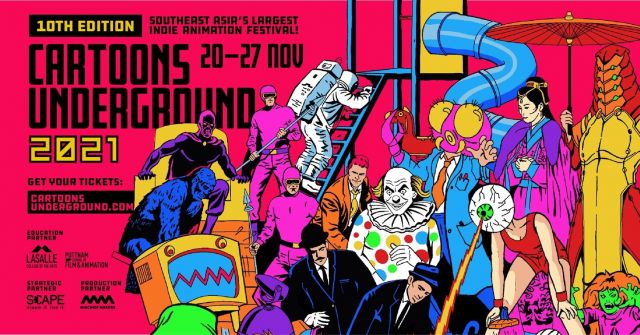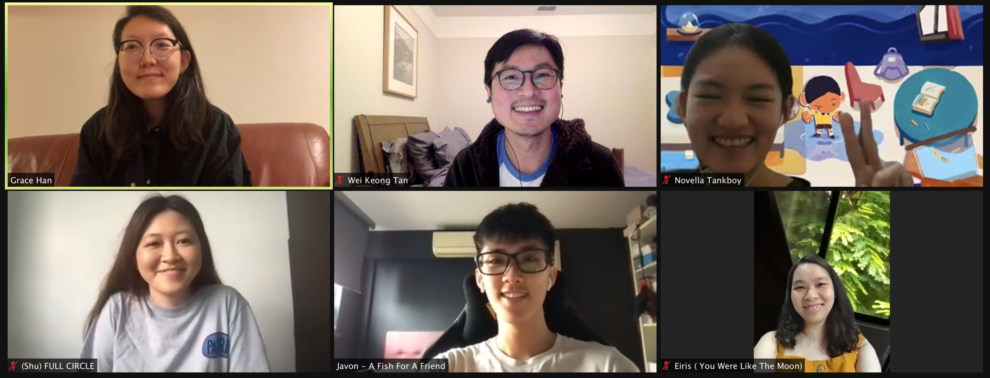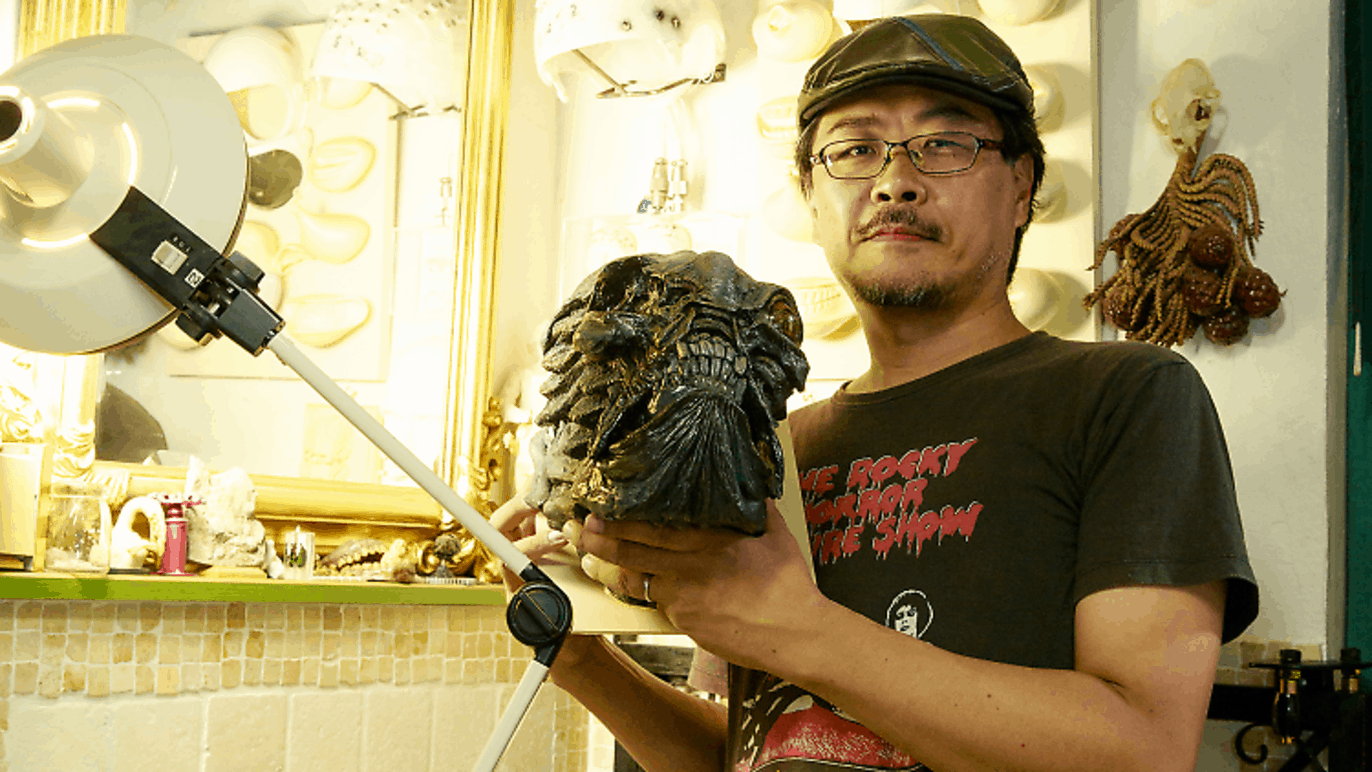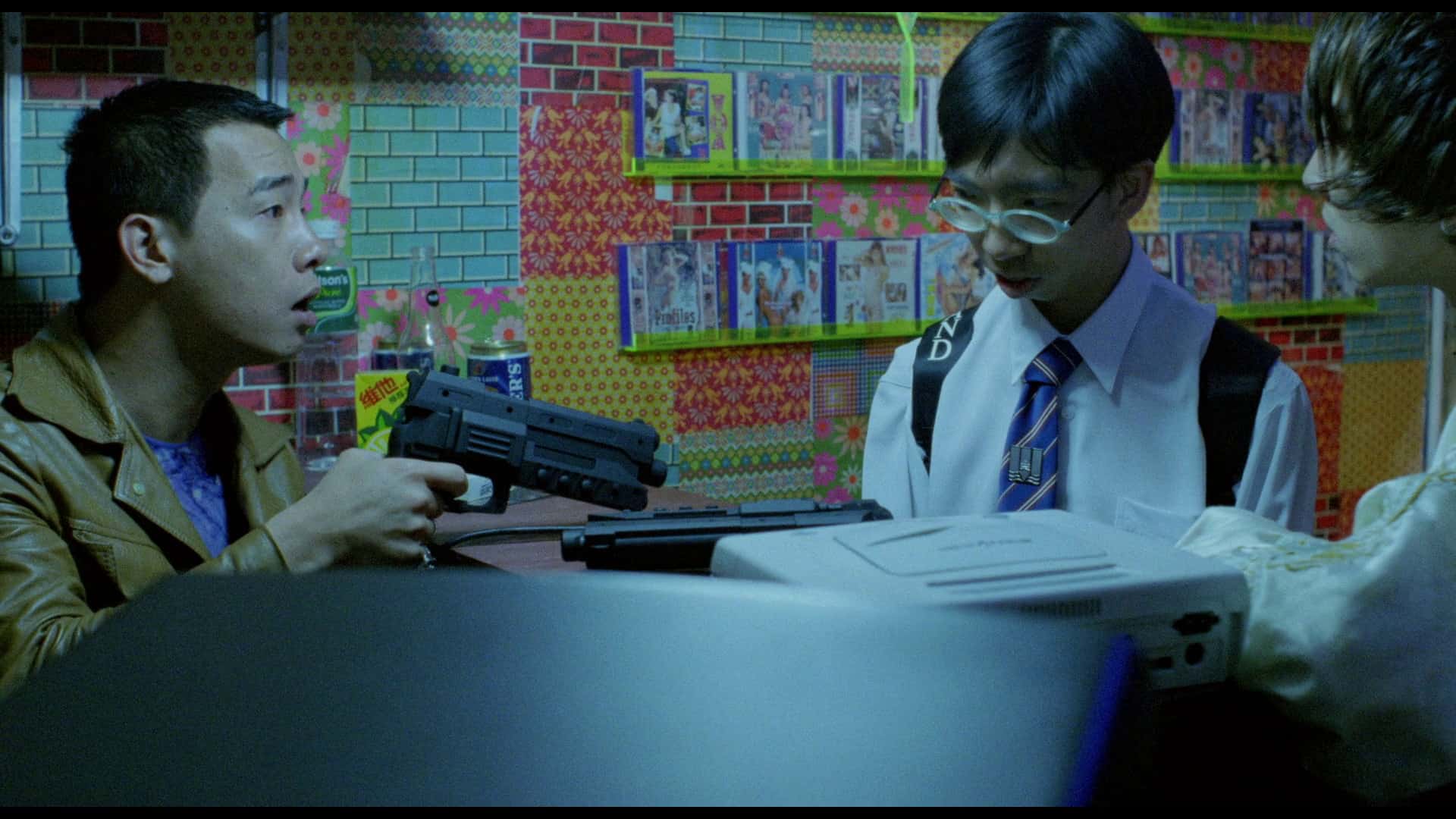The 10th edition of Cartoons Underground is once again online — so we at Asian Movie Pulse took the opportunity to see Southeast Asia's rising stars. We recently interviewed the Singaporean festival's student competitors over Zoom. Compared to last year, this year's selection feels more somber. But perhaps that is because everyone is simply older. Our interviewees are all recent graduates with strong illustration backgrounds this time around. Two of Singapore's three animation school powerhouses are represented here: Javon Chan Yi Da and Su Xian Yeow hail from Nanyang Technical University; Eiris Lu and Novella Lian stand in for LASALLE College of the Arts.
Their shorts display a range in medium as well. Javon Chan Yi Da's “A Fish for a Friend” stands out as a Pixar-esque, stylized 3D animated short. Su Xian Yeow's “Full Circle” leans heavily into print illustration, the film frames awash with blocks of color. Eiris Lu's quiet ode to her mother in “You Were Like The Moon” adheres to more plasmatic, “Lu Over the Wall”-esque character design. On the other hand, Novella Lian makes use of paper cutouts in “Tankboy,” an animated metaphor about social anxiety. Their filmic voices are vibrant, and their streamed voices even more so. We're delighted to present to you this year's round of up-and-coming animation talent in Southeast Asia.
This interview has been edited and redacted for clarity's sake. Many thanks to Programme Director Tan Wei Keong for organizing the call and providing extra details.

How did you come to study animation?
Su Xian Yeow (Shu): I'm actually not an animation major, but I do like Visual Communications. Making the image move was a bonus for me. After that, I ventured into experimenting with stuff. For a lot of us, illustration is just a still version [of animation]. The time, space, spec is a little different, but I think they all come hand-in-hand; joining together like a Venn Diagram.
Javon Chan Yi Da: I started watching cartoons when I was really young, and that inspired me to animate.
Shu: Being fascinated with how people create [cartoons] from nothing — like drawing it from nothing — became something that I wanted to do professionally.
Eiris Lu: For me, it was Miyazaki. When I first watched his film, I was really amazed by the way he tells his story. I really wanted to tap into that, into that sense of human emotion; to tell stories that resonate with people no matter where you are. I like to make people cry. I like to tell stories that will make you emotional. [laughs]
Novella Lian: I've wanted to animate since I was young. I watched too much TV then. I like a lot of different kinds of movies – I watch a lot of Indonesian soap operas, Marvel, Disney — everything. I wanted to be an actress, but apparently I cannot act. But I could draw. So I looked into animation – it's film and drawings at the same time.
How did you find your style? What directors did you look to?
Shu: I don't think I have a style yet. I'm inspired by “Waltz with Bashir” (Ari Folman, 2008). I also enjoy Miyazaki and Makoto Shinkai. They require more drawing skills. I also like the ones that were very accessible to us kids, like “Madeleine.” It was one of the anchors for why I started drawing animation.
Javon: I was inspired by a Pixar short film called “Feast.” I wanted to go for a 2D illustration look in a 3D space. I wanted to merge my style into illustrating this film.
Novella: For me, I'm more interested in children's picture books than in films. There's this artist in Tonka House called Chris Sasaki, who has a very flat illustration style. There's also Eric Carle, the one with the caterpillar. I thought that flat illustration language was interesting to explore for my graduation film. The narrative is very influenced by Oliver Jeffers – in its quirky tone. I also watched some Russian animation, like “The Hedgehog in the Fog.”
Eiris: Miyazaki is the obvious one. For illustration, I was inspired by Shaun Tan; I like how his illustrations are very surreal. That's what I wanted for my world as well. I tried to incorporate stylistic elements into my film.
Many of you have strong illustration backgrounds, work in illustration jobs, or derive inspiration from illustration itself. What do you all think of that connection, between animation and illustration?
Shu: I think that [animation and illustration] are very similar. Animation is like a series of illustrations. Illustration has a time-space vector of a single frame; I need to consider angles, dimensions, and so on. Animation needs more time. But I think a lot of animators are very proficient in illustration. It's a necessary skill set for conceptualizing and visualizing things that are not physically possible before you. The animation job comes as a secondary role as being an illustrator for posters. In job seeking too, a lot of positions mention that animation takes more time.
Eiris: I think the relationship between animation and illustration is quite intertwined. I also love the differences between the two. For me, I love subtlety. In illustration, I love to stare at an artwork; the longer you stare at it, the more details you see. That's what I love about illustration: you can look at it forever since it's a still image. For animated subtlety, I love how they just observe small movements that give characters more personality. Even simple things – like how someone drinks a cup of water, how one sneezes.
Javon: You can see the connections in style, like in “How to Train Your Dragon.” Nick O'Malley, the character designer for the film, really shows his style.
Novella: I agree with all three of them. [laughs]
In an ideal world then, would you stick with illustration? Or do you have a different dream job?
Shu: I would stick with the job I have at the moment. Animation is something I don't want to do professionally; it's more like a hobby for me. But if I had to animate, then it would be more on the animation side rather than concept art or storyboarding. I prefer to execute rather than conceptualize.
Javon: Shu has achieved so much more than other animation students in my degree. [laughs]
Shu: I am a general design major, but my final project was in video communication — which ended up in animation.
Wei Keong Tan (programming director): I think a lot of jobs in Singapore don't have specialized positions. Most of them hire generalists – so you're expected to do concept art, animation, and all, until you go on to a bigger company like Lucasfilm, Pixar, Disney.

Would you all want to stay in Singapore? Why or why not?
Javon: I would love to work from home with Pixar.
Shu: I think the work that illustration and animation demands in Singapore is still pretty narrow. It's usually in publishing or freelance. There's more demand in other countries. I prefer to have a full-time job that pays enough to survive.
Eiris: I want to be a traveling artist. I want to see the world and listen to stories and share my own. I feel like that is what channels my creativity and art in general. For the life for me, I cannot tie down a 9-5 job. I'm trying to work towards that right now.
Novella: Since I'm not Singaporean, I don't think I'll stay in Singapore. I do want to explore more though overseas. Ultimately, I want to go back to Indonesia and maybe work from Bali remotely. But I still want to explore.
What do you all think of Southeast Asian animation today? Of the future?
Javon: Right now it's more advertising. It's still very small. There aren't enough films in Singapore.
Shu: There's been a small increase since Finding Pictures and Robot Playground became popular. The pandemic has set us back too since we can't have huge groups of people to work on a project. I wonder in the next ten years – I don't see a world where there are enough jobs for people to get into animation. It'll be mostly advertising.
Novella: I agree with Su, but I'm more optimistic. Recently I heard about a new production house in Indonesia. Singapore, Indonesia, Philippines – there's a lot of experience here. [Hopefully] we can keep up the momentum and build a community. Netflix highlights more independent animation because of the pandemic. I think we just need to unite. I feel like something will happen.
You all mention the pandemic often here. Did it affect your production at all?
Shu: I mostly worked by myself, so the main issue was collecting materials and interviews in the material. They were closing shops at the time.
Javon: I had a group of six people. We could only work in groups of five or less – so one of us would have to sit out sometimes. We still worked in school though, since all the software we needed was there. We didn't work from home at all.
Eiris: I was in a group of two. The main issue is that we couldn't meet face-to-face, so we had to send the file back-and-forth. It slowed down the pace a bit. We just moved from school to home. We had half of everything we needed in the program to animate anyway.
Novella: Maybe it's because I started my career in the pandemic, but it wasn't that big of a deal. The past few years I have been working from home and it's been amazingly smooth for me. It's quite flexible and I can take a break when I need to. It's been quite cozy.
Do you have any other projects lined up?
Shu: I'm working on a film for the next festival season. It's about a bus ride and the people in it. There will be some experimental techniques I'm still exploring. I'm collaborating with someone who's good with Cyanotype screen and printing.
Javon: I'm too busy to create anything right now. But I think the next time I'll make something 2D, since it's more of a one-man endeavor. 3D requires a big team.
Eiris: I don't think I'll be making anything in the near future. I decided to focus on my art. I want to find what it means to do art, what my identity is in art, and so on – I'll find myself first before creating anything else.
Novella: I hope to make more and come back to my country with more.
And finally: Any pieces of encouragement for the next generation of filmmakers?
Eiris: Follow your heart, and do what you want! Don't be afraid to make something that is unconventional. You never know what it might do for you.
Novella: The pandemic is around and finding a job is hard, but… you can do it!















